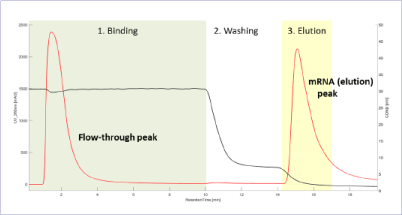This Application Note from BIA-Separations looks at the scaling up of messenger RNA (mRNA) on their Oligo dT Monolith column
Introduction
Messenger RNA can be produced by in vitro transcription reactions (IVT) or isolated from eukaryotic cells. One of the most convenient techniques for its extraction is the use of oligo deoxythymine (dT) coupled to a solid support. Oligo dT hybridizes to the poly-adenylated tail which is present on most eukaryotic mRNAs, or synthesized onto the molecule during IVT. Contaminant impurities, such as proteins, unreacted nucleotides, plasmid DNA, CAP analogs, partial transcripts, double-stranded RNA (dsRNA) side products, and enzymes lack the poly-A moiety and are not retained on the solid support. Chromatography using a solid phase consisting of large channels, such as monoliths, allows high flow rates and low shear forces and is easily scalable. These advantages can result in boosted recovery and productivity in the purification of biologics such as mRNA.
How the Chemistry Works

CIMmultus™ Oligo dT is a chromatography column with Oligo dT ligands covalently bound on its surface. The sample containing poly-adenylated mRNA is loaded onto the column in a high salt concentration buffer. Salt ions screen the electrostatic repulsion between the negatively charged backbones and allow interaction between the Oligo dT and poly-adenylated tail of mRNA.

Before product elution, a wash step at reduced salt concentration removes unspecifically bound contaminants. Elution of messenger RNA occurs under mild conditions in a low conductivity buffer at neutral pH. In the absence of salt, electrostatic repulsion between the negatively charged backbones of Oligo dT and poly-adenine destabilizes the T–A pairs and releases mRNA from the column.
Application Note
Purification of messenger RNA by affinity chromatography on CIMmultus™ Oligo dT column.
For a copy of this Application Note (PDF 570 KB) CLICK HERE
Both Oligo dT18 (C6 Linker) and Oligo dT18 (C12 Linker) column types are available. For more details on BIA-Separations columns go to our Columns and Media Page.

